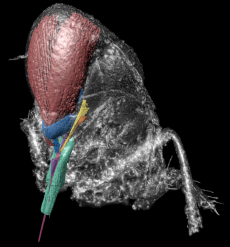NERSC Art Contest Winners Show Beauty in Science
October 23, 2024
By Elizabeth Ball
Contact: cscomms@lbl.gov
There is beauty in science: in curiosity, in effort, in thinking things through, in the illumination of new understanding. Sometimes beauty is also revealed in the process – to represent the natural world calls upon color, pattern, and symmetry.
To celebrate the beauty found in 50 years of science research, the National Energy Research Scientific Computing Center (NERSC) is pleased to announce the winners of the NERSC 50th Anniversary Science as Art Contest, announced Tuesday, October 22 at the 50th anniversary edition of the NERSC User Group Annual Meeting. The winners are organized by category and format.
People’s Choice
Still: Zarija Lukic, Andrew Myers, and Susan Brand - “Nyx Montage of an N-Body+Hydro Simulation of the Evolving Universe“ (2012–2024)
Still (Runner-up): Ken Chen - “Exotic Supernovae” (2016–2020)
Animation: Malte Buschmann - “The Birth and Death of Axion Strings” (2020–2024)
Animation (Runner-up): Ka Wai Ho - “Galactic Eddies: The Roiling Seas of Interstellar Space” (2023–2024)
Staff Picks
Still: Peter Nugent - “Nyx Montage of an N-Body+Hydro Simulation of the Evolving Universe“ (2012–2024)
Animation: Ka Wai Ho - “Galactic Eddies: The Roiling Seas of Interstellar Space” (2023–2024)
Animation (Runner-up): Malte Buschmann - “The Birth and Death of Axion Strings” (2020–2024)
Creatives’ Choice
Still: Julia Largett - “Siena Galaxy Atlas UMAP” (2024)
Still (Runner-up): Haoming Liang - “Fluctuations of Electric Field in Asymmetric Magnetic Reconnection” (2024)
Still (Runner-up): Stephanie Ribet - “Nanoparticles Beyond Their Phase Value” (2024)
Animation: Michael Zingale - “Rayleigh-Taylor unstable flame in Type Ia supernovae” (2004)
Animation (Runner-up): Seung-Hoe Ku - “Homoclinic tangle disturbance of the last closed magnetic surface, called magnetic separatrix, in DIII-D tokamak” (2022)
Editor's Pick
Still: Haoming Liang - “Fluctuations of Electric Field in Asymmetric Magnetic Reconnection” (2024)
Animation: Sarah Peery - “Magnetic Reconnection” (2024)
Visual Impact
Still: Ken Chen - “Exotic Supernovae” (2016–2020)
Still (Runner-up): Elizabeth Clark - “Anatomy of an Agricultural Antagonist” (2022)
Animation: Matthew Bonnani - “Large-eddy simulation of the AFRL rotating detonation rocket engine” (2022–2024)
Animation (Runner-up): Claudia Parisuana - “Water droplet blown up by an x-ray free electron laser” (2023)
Animation (Runner-up): Max Gallant - “Solid-State Reaction Automaton” (2022–2024)
Best Historical
David Trebotich - “Pore Scale Reactive Transport in Calcite” (2012)
Best Use of 3D
Still: Weiru Chen - “T center in silicon” (2022)
Still (Runner-up): Guy C. Moore - “Magnetization and magnetic field from source-free exchange-correlation functional” (2023)
Animation: Dani Ushizima - “Ceramic matrix composite microCT image acquired with X-ray synchrotron at LBNL’s particle accelerator and result of fiber detection” (2015)
Animation (Runner-up): David Trebotich - “Flow in paper pressing drying felt” (2017)
Best Use of Color
Still: Min Gee Cho - “Every Particle Matters”
Still (Runner-up): Stephanie Ribet - “Polymer party across the spectrum” (2024)
Animation: Hasitha Sithadar - “Sand under pressure” (2023–2024)
Animation (Runner-up): Victor Ovchinnikov - “Molecular Dynamics Simulation of Universal Nanoparticle Flu Vaccine Candidate” (2024)
About NERSC and Berkeley Lab
The National Energy Research Scientific Computing Center (NERSC) is a U.S. Department of Energy Office of Science User Facility that serves as the primary high performance computing center for scientific research sponsored by the Office of Science. Located at Lawrence Berkeley National Laboratory, NERSC serves almost 10,000 scientists at national laboratories and universities researching a wide range of problems in climate, fusion energy, materials science, physics, chemistry, computational biology, and other disciplines. Berkeley Lab is a DOE national laboratory located in Berkeley, California. It conducts unclassified scientific research and is managed by the University of California for the U.S. Department of Energy. »Learn more about computing sciences at Berkeley Lab.








